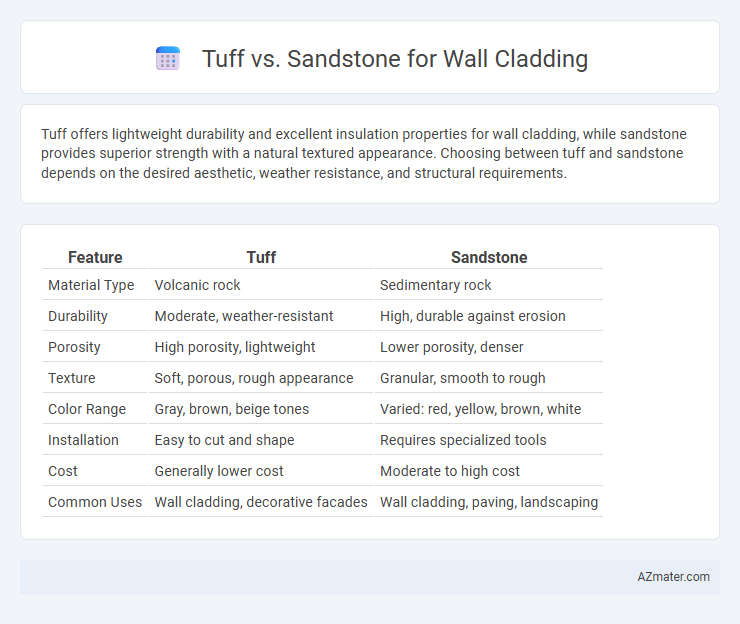Tuff offers lightweight durability and excellent insulation properties for wall cladding, while sandstone provides superior strength with a natural textured appearance. Choosing between tuff and sandstone depends on the desired aesthetic, weather resistance, and structural requirements.
Table of Comparison
| Feature | Tuff | Sandstone |
|---|---|---|
| Material Type | Volcanic rock | Sedimentary rock |
| Durability | Moderate, weather-resistant | High, durable against erosion |
| Porosity | High porosity, lightweight | Lower porosity, denser |
| Texture | Soft, porous, rough appearance | Granular, smooth to rough |
| Color Range | Gray, brown, beige tones | Varied: red, yellow, brown, white |
| Installation | Easy to cut and shape | Requires specialized tools |
| Cost | Generally lower cost | Moderate to high cost |
| Common Uses | Wall cladding, decorative facades | Wall cladding, paving, landscaping |
Introduction to Wall Cladding Materials
Tuff and sandstone are popular wall cladding materials valued for their durability and aesthetic appeal in architectural design. Tuff, a volcanic rock, offers lightweight properties and excellent thermal insulation, making it suitable for energy-efficient buildings. Sandstone, known for its natural texture and wide range of warm hues, provides robust weather resistance and timeless elegance in both interior and exterior wall applications.
What is Tuff? Key Properties and Formation
Tuff is a type of volcanic rock formed from consolidated volcanic ash ejected during explosive eruptions, characterized by its porous and lightweight structure. Its key properties include low density, high porosity, and good insulation capabilities, making it suitable for wall cladding applications where thermal performance and ease of installation are important. The porous nature of tuff also offers good weather resistance, but it requires proper sealing to prevent water absorption and ensure durability compared to denser stones like sandstone.
Understanding Sandstone: Characteristics and Types
Sandstone, a sedimentary rock composed primarily of quartz and feldspar, exhibits diverse characteristics including grain size, porosity, and color variations ranging from beige to red, which influence its durability and aesthetic appeal for wall cladding. Common types used in construction include quartz sandstone, arkose, and lithic sandstone, each varying in mineral content and texture, affecting weather resistance and maintenance needs. Its natural thermal insulation and ease of shaping make sandstone a popular choice for both interior and exterior wall cladding applications, where both structural integrity and visual warmth are desired.
Aesthetic Appeal: Tuff vs Sandstone
Tuff offers a unique aesthetic appeal with its porous texture and earthy tones, creating a rustic and natural look ideal for contemporary wall cladding. Sandstone provides a smooth finish with warm hues ranging from beige to reddish-brown, delivering a classic and timeless elegance in architectural designs. Both materials enhance aesthetic appeal through their distinct visual characteristics, with Tuff emphasizing texture and Sandstone highlighting durability and color consistency.
Durability and Longevity Comparison
Tuff stone offers superior durability for wall cladding due to its volcanic origin, providing excellent resistance to weathering, erosion, and freeze-thaw cycles, making it ideal for long-term external applications. Sandstone, while aesthetically versatile and widely used, generally has lower hardness and porosity rates, resulting in greater susceptibility to chipping, staining, and surface degradation over time. Choosing tuff ensures enhanced longevity and reduced maintenance costs compared to sandstone in harsh environmental conditions.
Weather Resistance: Performance in Various Climates
Tuff exhibits superior weather resistance compared to sandstone due to its volcanic origin and dense composition, making it highly durable in both wet and dry climates. Sandstone's porosity causes higher water absorption, leading to potential erosion and surface degradation in freeze-thaw conditions or heavy rainfall areas. Consequently, tuff is often preferred for wall cladding in regions with extreme weather variations, ensuring longevity and minimal maintenance.
Installation Process: Ease and Costs
Tuff offers a more straightforward installation process for wall cladding due to its lightweight nature, reducing labor time and equipment costs compared to sandstone. Sandstone, being denser and heavier, often requires reinforced support and skilled labor, increasing installation complexity and expenses. Overall, tuff provides a cost-effective solution with quicker installation, while sandstone demands higher upfront costs and extended effort for proper mounting.
Maintenance Needs for Tuff and Sandstone
Tuff requires minimal maintenance due to its natural porosity, which helps it resist weathering and staining, making it ideal for exterior wall cladding. Sandstone, while aesthetically appealing, typically demands more frequent sealing and cleaning to prevent erosion and discoloration caused by moisture absorption. Choosing tuff over sandstone can significantly reduce long-term upkeep costs and effort for building facades.
Environmental Impact and Sustainability
Tuff offers a lower environmental impact than sandstone due to its volcanic origin, which requires less energy-intensive extraction and processing. Sandstone quarrying often results in greater habitat disruption and higher carbon emissions. Both materials are durable, but tuff's porous nature may enhance thermal insulation, contributing to improved energy efficiency in buildings.
Final Verdict: Choosing the Right Stone for Wall Cladding
Tuff offers excellent durability and a unique porous texture that enhances insulation, making it ideal for weather-resistant wall cladding. Sandstone provides a classic aesthetic with natural color variations and ease of carving, suitable for decorative facades and historic restorations. Choosing between Tuff and Sandstone depends on the desired balance of durability, appearance, and maintenance requirements specific to the wall cladding project.

Infographic: Tuff vs Sandstone for Wall Cladding
 azmater.com
azmater.com